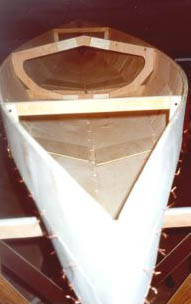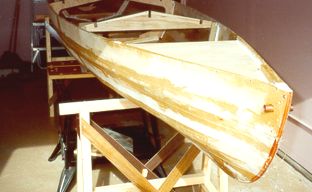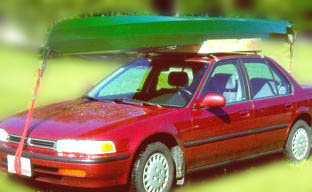
The 16' two person Plywood and Fibre Glass Kayak
After building a variety of different styles of
kayaks over the last 23 years,
I decided I was ready for another challenge.
Previous kayaks included 15'two-seater sea kayaks made from canoe canvas over a wooden frame, (the easiest to build and the most stable, but also having the most drag). 1 have also built 12'single-seat touring kayaks made entirely out of fibre glass and capable of carrying ample camping gear.
All my kayaks are a cross between an open canoe and a sea kayak in that the top decking is partially covered, creating a large open cockpit to climb into and for easy storage of gear. The paddlers do not wear water-protective skirts; therefore these kayaks are not intended for white water, rough seas or to roll over.
My latest creation is a "stitch and glue" kayak covered with fibre glass cloth and resin. This is not a new discovery as many amateur builders have used this technique. 1 decided that this kayak would be 16' long, 32" wide, and 10" high to the gunwales, (14" overall height) and accommodate two adults plus gear.
The construction material is one-eighth inch plywood. Three long strips are used for each side. A temporary frame is made to assist in forming the shape. The idea is that each piece of plywood is precisely shaped so that when stitched together, they will form the desired shape (the port side cross-section being a mirror image of the starboard side). The stitching consists of drilling very small holes every 4 inches along the edges, and lined up with similar holes on the adjoining piece, then using short lengths of 20 or 24 AWG copper wire stitches twisted on the inside to hold the edges together.
3' fibre glass tape and isophthalic resin is used along the inside of the seams, over the stitching. Isophthalic resin (iso for short) was recommended to me by RAYPLEX LTD as an ideal resin to use throughout this project, as it does an adequate mob for the lowest cost. On the outside, the stitches are cut flush with the plywood, and then another length of 3" tape and resin applied along each outside seam. The temporary frame is then removed from the inside. The inside is finished with a single coat of resin.
Any desired half inch plywood framing is fitted on the inside for added strength and to support seats and a couple of floor boards to take your weight as you climb in and out. All wood framing is coated with resin. Styrofoam pieces are shaped and fitted into the bow and stern for floatation.
The top decking with the open cockpit is constructed from the same plywood as the hull. It is this decking that gives the kayak its full strength. The decking is first coated with resin on the underside before installation. 3' tape is used along the gunwales to hold the decking to the hull.
Finally, the entire outside of the hull and deck is covered with lightweight cloth and iso resin. The outside of the kayak is then sanded and pained with a good quality marine paint again supplied by Rayplex.
This completed kayak will weigh less than 60 pounds and will easily carry 350 pounds.
Al. Plummer
Consecon, Ontario, Canada.



|
For more information on these
and other products |